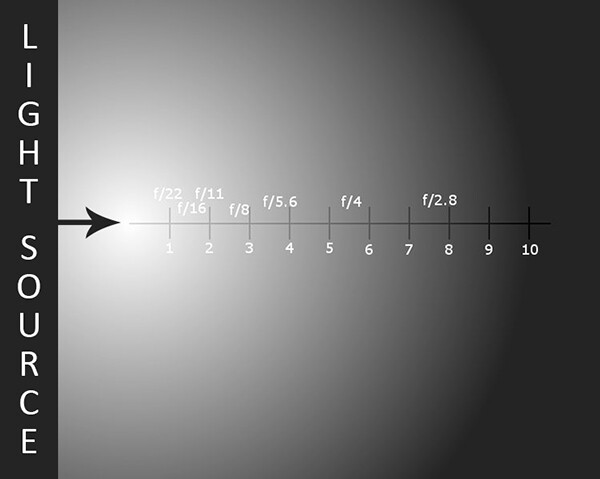Mugwump wrote:
I don't know what more you want me to say which isn't saying what I've already said countless times.
Take a regular torch. It's not the sun. But it doesn't need to be because light behaves in exactly the same fashion (with one or two exceptions which really only apply in theoretical environments).
The Inverse Square Law states that
light intensity is inversely proportional to the square of the distance to the source. Roughly translated this means that you lose the MOST of your light CLOSEST to where it originates and as the distance increases this falloff diminishes toward zero
at an ever diminishing rate without ever reaching zero.

In the illustration above HALF of the total output will be lost in the first few inches. Double the distance and it is reduced to a quarter and so on etc. But the important point in relation to this discussion is what's taking place at the other end of the scale. The reason we see starlight across vast distances is because even though its intensity is ALWAYS falling - the further light travels from the source the longer it takes to do so. Plug the numbers into any calculator and you can immediately verify this.
If the Apollo photographs are genuine then the single light source illuminating the subject (the sun) is 150 million km away. At that distance most of its intensity has been diluted and the rate of falloff drops to negligible levels. Sure, it's still higher than what it would be if we were viewing the sun from the other side of the galaxy. But we aren't seeing the kind of colossal bites taken out of luminosity that we witnessed early on.
Consequently we should see
no appreciable difference in the luminosity of any part of the moon exposed to direct sunlight and not interfered with by shadow.
Great. Got that. So, provide a good example which you argue shows a difference in luminosity, and we can talk. I think I can see your beginner's errors already, but in case I misunderstand, i await a specific example.
Mugwump wrote:
Now, there are some complicating factors relating to a variety of issues which can result in the distant background looking slightly duller and/or desaturated (especially on the earth where this question is further complicated by our atmosphere which scatters light and can function as an enormous softbox).
But if you are looking at an Apollo photograph in which there are significant differences in luminosity that would require you to alter your camera's shutter speed and/or f/stop to correctly expose each area - and these discrepancies cannot be explained by the sun's light being obscured by some object - it has either been tampered with in post-production or it was photographed in a studio environment.
Great. So, let's look at an Apollo photograph which you think has such significant differences, and is therefore not genuine.
Mugwump wrote:
Take a look at the original NASA stock. We see this issue cropping up time and time again (notice I DO NOT say ALL). Just as we see other problems such as harshly backlit subjects which - despite the astronauts carrying NO SECONDARY SOURCES OF ILLUMINATION - are perfectly illuminated from the front.
Bear in mind that in order to achieve the above you have to supply CLOSE TO the same amount of light in the opposite direction in order bring the subject within the tonal range of the camera. Which means you either have to set up a portable flash-unit to fill in the shadow areas - or (maybe) use a very efficient reflector (neither of which the astronauts carried). Without it the subject MUST BE reduced to a pitch-black silhouette.
There's simply no room for debate on this question. [/quote]
Sorry, but just total nonsense. Very obviously, the regolith reflects scattered light, by which I can (despite your inverse square law theory) read a newspaper on Earth, a quarter of a million miles away from the regolith. This reflected light therefore is very plainly going to illuminate any object on the Moon's surface. It would take a very special kind of myopia not to grasp that simple point. The only reason you can see ANYTHING on all the Moon images (bar the ones taken with flash) is because of reflected light. Reflecting from object to eye or object to object to eye etc.
Mugwump wrote:
Don't believe me? Try it yourself. It isn't a difficult experiment to set up.
It isn't a question of "belief", but simple science. I don't need to try "simple experiments" because this theory has already been debunked including by people who have already done these sort of simple experiments. For example:

Is this simple experiment a NASA fake too? Or is that just how basic refection works, and your theory falls at the first hurdle?
And, you conveniently overlook the fact that the Sun may be the primary source of lighting, but (if you believe the Earth is a globe and was in the Moon's sky) there would be earthshine too.
And you fail to take into account that the spacesuit is by design more reflective than the regolith. And another source of additional illumination is the white spacesuit of the astronaut taking the image.
Mugwump wrote:
This is why I draw the distinction between natural light and theatrical (make-believe) light.
Light is light. It either is, or isn't. There's no "make-believe" light. But unlike some, as a seemingly keen photo expert, I'd be pretty sure you'd seen the debunks of this rather crude point before so I wonder why you make it in 2016 when it has already been demonstrated to be bad science?
Mugwump wrote:
Now, if you don't mind I'm calling it quits on repeating the SAME THING OVER AND OVER AND OVER AGAIN. Quite frankly, I'm bored rigid with the whole issue and there's only so much stupidity I can take.
I mean, if you have any genuine interest in this question you'll spend five minutes setting up two or three simple experiments which will tell you more about photography and light than NASA seems willing to divulge. It really is THAT SIMPLE.

Nah, the only person with issues here is you. If you're not playing devil's advocate. Once hard evidence came into existence of the FACT of the Moon landings, by way of high definition imagery from both the LRO, and the Chang'e missions, that was the point where hoax proponents should have held up their hands and admitted defeat. To continue to claim that man was never on the moon goes hand in hand with a need to explain that the images are fakes from a studio. But once you KNOW they landed, so you KNOW man was on the Moon as claimed all those years ago, then if you want to go on claiming that the images were not taken on the moon, you really are moving to Occam territory - they ent up there - they PRETENDED to take images - but actually decided to instead fake them all? From ALL the moon landing missions? Fake thousands of images? (Or are the images from the rest of the landings real? You don't say).
WHY? You've spent billions to stand on the moon yet you take no images? You think that? Then clearly it's YOU who has "no genuine interest in the question", instead you have metaphorical wool in your ears and a bag over your head, and are impervious to evidence.












